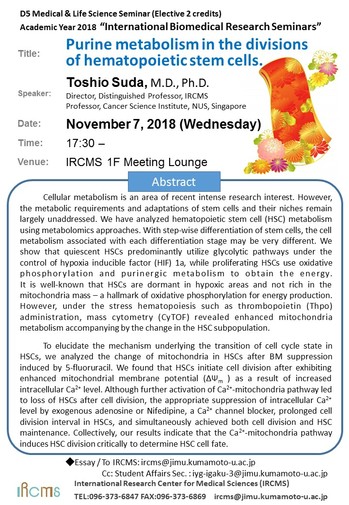- HOME
- News & Events
- [November 7]*D5 Medical & Life Science Seminar*
News & Events
[November 7]*D5 Medical & Life Science Seminar*
October 15 2018
The "D5 Medical & Life Science Seminar" course will be offered by International Research Center for Medical Sciences (IRCMS). It will run from May 2018 to March 2019, with lectures given by scientists affiliated or collaborated with the IRCMS. The course theme for this academic year is "Basic research for understanding disease mechanisms". The lectures will be given once a month, in English, and by leading scientists in the relevant research field. Students will be taught: 1) how normal physiological functions are maintained in human hematopoietic, vascular, immune, reproductive and nervous tissues and organs; 2) how abnormalities in these systems (e.g., cancer) are studied using experimental models; 3) cutting-edge technologies (including single cell level imaging and omics analysis) used for mechanistic understanding of these abnormalities; 4) efforts and progresses in finding cure for human diseases associated with these abnormalities; and 5) importance of understanding disease mechanisms using
Date : November 7, 2018 (Wed)
Time : 17:30 -
Venue : IRCMS 1F Meeting Lounge
Speaker : Toshio Suda, M.D., Ph.D.
Title : Purine metabolism in the divisions of hematopoietic stem cells
Abstract :
Cellular metabolism is an area of recent intense research interest. However, the metabolic requirements and adaptations of stem cells and their niches remain largely unaddressed. We have analyzed hematopoietic stem cell (HSC) metabolism using metabolomics approaches. With step-wise differentiation of stem cells, the cell metabolism associated with each differentiation stage may be very different. We show that quiescent HSCs predominantly utilize glycolytic pathways under the control of hypoxia inducible factor (HIF) 1a, while proliferating HSCs use oxidative phosphorylation and purinergic metabolism to obtain the energy.
It is well-known that HSCs are dormant in hypoxic areas and not rich in the mitochondria mass - a hallmark of oxidative phosphorylation for energy production. However, under the stress hematopoiesis such as thrombopoietin (Thpo) administration, mass cytometry (CyTOF) revealed enhanced mitochondria metabolism accompanying by the change in the HSC subpopulation.
To elucidate the mechanism underlying the transition of cell cycle state in HSCs, we analyzed the change of mitochondria in HSCs after BM suppression induced by 5-fluoruracil. We found that HSCs initiate cell division after exhibiting enhanced mitochondrial membrane potential (ΔΨm ) as a result of increased intracellular Ca2+ level. Although further activation of Ca2+-mitochondria pathway led to loss of HSCs after cell division, the appropriate suppression of intracellular Ca2+ level by exogenous adenosine or Nifedipine, a Ca2+ channel blocker, prolonged cell division interval in HSCs, and simultaneously achieved both cell division and HSC maintenance. Collectively, our results indicate that the Ca2+-mitochondria pathway induces HSC division critically to determine HSC cell fate.

